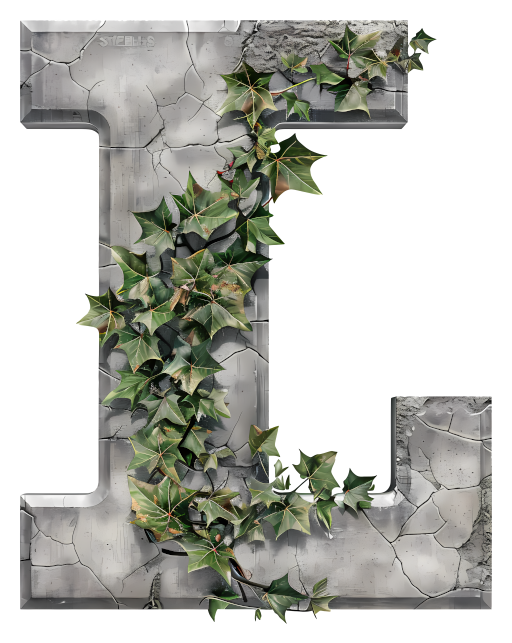Behind the “read more” are lots of photos, so if you’re not on a good connection, beware. This is also replacing FBEL for the week, because I don’t have the mental space to write about politics right now. I hope you enjoy.
This past weekend was the first of three at Maine Renaissance Faire. It’s a lot of fun, a TON of work, and you never know what the weather will be. This is my fourth year presenting at MERF (as we call it), and though three weeks is a LOT at a single site, I have been looking forward to it.
When I prepare for a faire, I need to worry about different types of things. First, I need to address my infrastructure. When I’m at MERF, I get to use the kitchen tent of the Brotherhood of the Arrow and Sword, which is my 15th century historical group. They’ve been around for a couple of decades now, and so they’ve acquired the kind of equipment that I can only dream of. They have many amazing looking tents, trestle tables, medieval lamps and tripods and clothing, things I’m still working at achieving and creating. I have better cookware than they do, though. 😀
Their kitchen tent is a massive wedge that opens on one side. In modern parlance we’d call it a Baker’s tent, though it’s much larger than any one I’ve ever seen before. It can be used with the front closed, making it a plain old wedge tent (albeit one large enough to hold six queen sized air beds with room to move around) or you can put the side up (as seen in the pictures below) to use it for vending out of. This is where I sell my cookbooks, and where my cooking demonstrations begin (they end at the fire, of course).
The other tents are the type used by various medieval military. There are some bell wedges (wedges with ends that bump out to give you a bit of extra room), some square and rectangular wall tents, and a round tent (the most usual used by the average knight, at least according to paintings). My own tent is a tiny wedge, just big enough for me and a small cot and my personal gear. It, too, opens on one side (just like its big brother, the kitchen tent), but it’s not tall enough for most people to stand under. I’m tiny (only 5’1″), so it works for me. I have to stoop a bit, but not much, and I can get dressed standing up by shoving my cot on its side. When I’m at an event with my sweetie, though, we need something larger. We’ve been staying in the “modern camping” area for the past few years, in a very modern pop up easy set up tent that accommodates our queen air bed. I wanted to be closer to my Brotherhood, though, and so my sweetie finagled a “long term borrow” of a 9×9 wall tent for our use from his sister. It is just large enough for our queen bed, our personal clothing bags, and one “gear box” each. Luckily that’s all we really need, as other items are either stored in the car (cash box, harp) or in the kitchen tent (cast iron, chairs, tables).
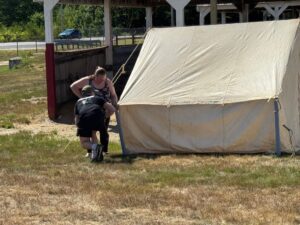
Wall tents are not pop up tents. My pop up tent takes literally one minute, only sixty seconds, to set up with two people, or two minutes to do it alone. The wall tent pictured here? It took 15 minutes to set up. And can I just say, that’s a ridiculously quick set up for a wall tent, and I’m pleased as punch. It has an interior ridge pole and a front and back upright pole which go in first. Technically, we could simply stake off the four corners with their tiny wall poles, and be done with it, but I know our fairs. We get howling winds, ridiculous storms, and the occasional microburst that shreds unsecured tents in their wake. We used two guy lines from the front and back of the tent to hold the uprights in place, then staked the four corners as well. The first attempt wasn’t perfect, but worked. We had to adjust before Sunday’s storm hit us, but I managed that on my own (thank you short walls) and we were fine. This is not a medieval tent. It’s a French and Indian War era repro tent. But it’s canvas, and it’s not modern in shape, so it’s close enough. I plan to add some removable dagging along the short walls to give it a more medieval look, but other than that, we’re keeping it as is. It has a waterproof (tarp) floor inside, over which we have a fabric “pretty/comfortable/soft” floor. It holds our queen size Coleman air bed, which is pretty much a requirement for me and my sweetie (I’m 54 with hip issues and I’m fat, and he’s … well, older than me by quite a bit, though lean and very fit… neither of us is young and we’re not getting up off the ground anymore). I slept very well both nights we were on site, though I resent the giant stadium light that is right above us. I may throw a big grey tarp over the tent at night just to avoid the bright light.
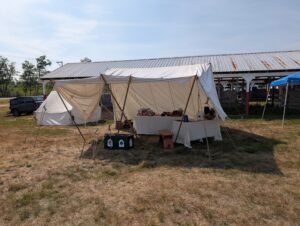
This is the kitchen tent. You can just see the outline of my small tent behind and to the left. The kitchen tent is roomy and secure. The box out front (green with heraldic images on it) belongs to the Brotherhood and includes our plates, spare cutlery, marshmallow/hotdog forks, and the like. The two tables inside there are my own, and are currently plastic fold up ones. Eventually I’ll have trestle tables, but for now, plastic will do. I cover them with old white bedsheets, and tie the sheets to the legs so they mostly don’t show. The larger back table holds all sorts of things, and the one that’s closer to us is my prep table where I have my cutting boards, knives, and other cooking utensils. The cooler goes under this table, hidden by its own cover, and that way I have my food close at hand without having to expose something overtly modern. I take my gear and supplies up in Rubbermaid tubs (because they’re waterproof, and in a storm emergency, things can get tossed in them to keep them safe and dry), and these are stashed behind the tent (when we’re in a place that people can’t walk behind us) or inside the tent behind the tables and chairs (like at MERF). I cover them with a giant canvas tarp I made out of scavenged fabric so they don’t stick out. The one modern thing that is clearly visible is our fire extinguisher, because safety trumps “looking good” every time. What you can’t see is the small wooden table that holds a ceramic crock with a spout. I keep water in it, and keep it iced, so that people can come cool down and hydrate, because these events are basically dehydration moments waiting to happen.
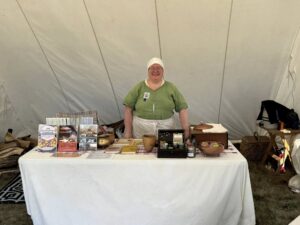
I like to keep one end of the table for my cookbooks, and the other end a display of the foods and spices I use in my cooking. In this image you can just see the water crock off to the right of the pic. I keep powdered Gatorade on hand to help stave off dehydration, and also a new thing called LMNT which is Gatorade on steroids for those of us who are low sodium folks and need help not to keel over in the heat. Staying hydrated is something we all take incredibly seriously, because every single one of us has seen someone puking in a garbage can because they’re going through the “middle stages” of heat stroke. It’s not fun, and we do our best to take care of our own.
When you add in that not only are our guys wandering around in boiled wool and layers of linen, they’re also then donning more wool padding and then steel armor over the whole thing, you begin to understand just how important my little iced crock of water and my food is. Many vendors at ren faires will just eat fair food from the various food vendors on site. This is not something that the fighters can do. Eating fast food of any kind is just going to make you sick. My cooking medieval recipes made with whole foods and no junk is exactly what keeps them going. I’m proud of my contribution to the Brotherhood. 🙂
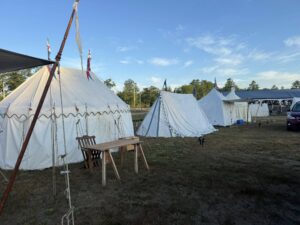
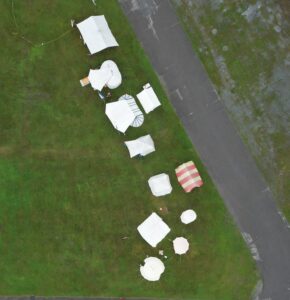
Here are the tents that the Brotherhood sets up. At Maine we are lacking some of our fighters (they are off at other events sometimes), so the full overhead display you see on the right hand picture (which is from Vermont faire, which I didn’t attend) is not our current set up (in the pic on the left, which is from Saturday). You can see the lovely small personal trestle table that one of our knights has, along with his reproduction medieval chair. We have heraldic flags flying off the tops of many of the tents, to let people know who resides in them. We have am armory tent, where we have displays of armor and weapons used in the 15th century by the various soldiers and knights. We have it set up so kids can come in and try on gauntlets and helms, and get up close to (but not touch) the swords and such. We also have practice swords (which are wooden and have no cutting edge) which they can actually touch. It’s amazing to watch a bunch of littles come running through, excited to be up close to the men and women in armor, asking questions and bouncing with happiness. I love the patience with which each question is answered. The men and women I work with in the Brotherhood take the time to get down on the level of everyone who walks in.
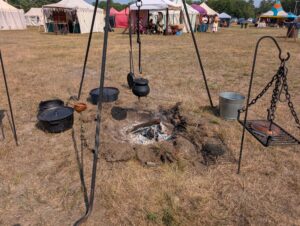
 Here’s my cooking set up from this past weekend. The big tripod belongs to the Brotherhood (though I have a tiny version of it that I use when I’m on my own), and it will hold a whole pig if you need it to. The spiky hook thing hanging down from the center is called a trammel, and it is the temperature gauge for fire cooking. Move the hook down (closer to the fire) and the temperature goes up. Move the hook up (farther from the fire) and the temperature goes down. The little fat bellied pot I’m cooking with there contained rice at the time. The large cast iron pots are mine and one had “alloes of beef” in it, and the other hand “chickpeas in almond milk.” Along with fat slices of fresh bread and cheese and pickles, this made a very hearty meal for everyone in our encampment. One of the neat items the Brotherhood has that I don’t, is the hanging rack you can see in the right hand picture. I was using it to hold a pot lid at the time, but you can use it to grill meat, or put a fry pan onto, to allow you to cook closer to the fire.
Here’s my cooking set up from this past weekend. The big tripod belongs to the Brotherhood (though I have a tiny version of it that I use when I’m on my own), and it will hold a whole pig if you need it to. The spiky hook thing hanging down from the center is called a trammel, and it is the temperature gauge for fire cooking. Move the hook down (closer to the fire) and the temperature goes up. Move the hook up (farther from the fire) and the temperature goes down. The little fat bellied pot I’m cooking with there contained rice at the time. The large cast iron pots are mine and one had “alloes of beef” in it, and the other hand “chickpeas in almond milk.” Along with fat slices of fresh bread and cheese and pickles, this made a very hearty meal for everyone in our encampment. One of the neat items the Brotherhood has that I don’t, is the hanging rack you can see in the right hand picture. I was using it to hold a pot lid at the time, but you can use it to grill meat, or put a fry pan onto, to allow you to cook closer to the fire.
Before I start my fire each morning, and several times through the day, I take the tin pail you can see in both pics, and I use it to wet the grass and dirt all the way around my fire. This keeps any errant sparks from catching in the grass and getting out of control. I always have water on hand in case of fire escaping its bounds. This is one of those lessons learned through trial and error. I’ve had the Washing Well Wenches call me out over the mic because a spark got into the grass and was crawling through the very dry tinder. That’s an embarrassment you never forget LOL! I now do this with ALL fires I have, even ones in my brazier. My water bucket is always at hand even if there’s also a fire extinguisher nearby.
When I dig my firepit (and I almost always do it myself unless I’m on my own and getting paid “the big bucks,” in which case I sometimes make the organizers do it for me), I try to do so in a grid. I take out the sod and place it around the edge of the firepit. This achieves two things. First, it makes a bit of a wind break for the fire, and second, it makes it that much deeper. When the fair is over and the fires are all out for good, the sod gets returned to its spot and normally that becomes a very green spot of grass (the nitrogen from the ashes makes good grass fertilizer). This fairgrounds happens to be perpetually dry, and my sod trick really didn’t work. I simply dug out what I could, and I’ll place the divots back when I’m done. I don’t expect the grass to grow well. I’m not worried, either, as it’s the same spot as last year, and probably next year.
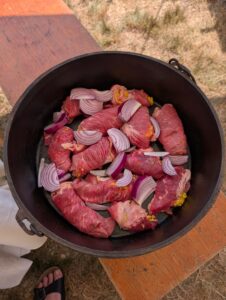 I made two very nice cooked dishes for the weekend, for my display and demonstration. The first is “alloes of beef,” and I’ve shared the recipe on here before. Basically, slice an eye of round roast to half inch slabs, beat them until they’re very thin, stuff with a bread/egg/spice mix, and then toss into the dutch oven. Cover most of the way with Guinness beer, and cook on a low flame until the beer turns into a thick, soupy gravy and the meat is falling apart delicious. At one point, everyone had mouthfuls of it and was making moaning sounds, and a random friend wandered into camp and just looked around and snorted at us.
I made two very nice cooked dishes for the weekend, for my display and demonstration. The first is “alloes of beef,” and I’ve shared the recipe on here before. Basically, slice an eye of round roast to half inch slabs, beat them until they’re very thin, stuff with a bread/egg/spice mix, and then toss into the dutch oven. Cover most of the way with Guinness beer, and cook on a low flame until the beer turns into a thick, soupy gravy and the meat is falling apart delicious. At one point, everyone had mouthfuls of it and was making moaning sounds, and a random friend wandered into camp and just looked around and snorted at us.
I made a salad, also from a medieval recipe. Normally, people from the 12th through 16th centuries didn’t eat raw vegetables or fruit, so I was surprised to find a cold, raw salad. It looked interesting, and I dutifully picked up all the ingredients. I wasn’t really paying attention when I did it, so when I began to assemble it, I was a bit confused. Leafy greens, check. I picked up a spring mix box, and some arugula and spinach. Finely chopped broccoli; I used broccoli slaw to avoid the work of chopping. Capers. Hmm… salty in a salad, that might be good. Olives, specifically green ones. Okay, that doesn’t sound too bad. Wedges of orange. What? Wait a sec… and FIGS? Diced figs? What the heck. And then some nuts (it called for slivered almonds but I used walnuts because it’s what I had). All with a vinegar and oil dressing. I made it as written, but I honestly wasn’t expecting much. Sometimes, medieval recipes are just a fail for the modern palate, and I accept that. Still, it was cool, and it LOOKED refreshing. Then we started eating it. It was amazing! The salty and sweet and the tart of the dressing was just perfect. It blew me away how delicious it all was. At the end of the day, I usually have about a third of salad left, but this time there were a couple of stray bits of broccoli, and a diced piece of fig, and nothing else.
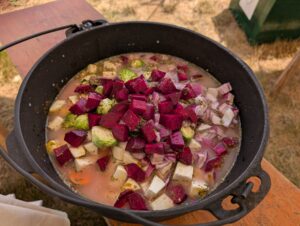 I also cooked up “chickpeas in almond milk,” which is essentially chickpeas and a bunch of vegetables stewed in almond milk with curry. It’s based on a 15th century middle eastern meal that was brought to England, likely during or after the Crusades. I ended up using red onions, beets, carrots, parsnips, purple top turnip, and some brussel sprouts for the green. You pour almond milk over it, whisked with curry in it. I went for mild curry, as I know some people in my group have difficulty with spices (me included). The end result was slightly sweet, and very delicious. We served it (and the beef) over a rice and quinoa mix that I precooked at home.
I also cooked up “chickpeas in almond milk,” which is essentially chickpeas and a bunch of vegetables stewed in almond milk with curry. It’s based on a 15th century middle eastern meal that was brought to England, likely during or after the Crusades. I ended up using red onions, beets, carrots, parsnips, purple top turnip, and some brussel sprouts for the green. You pour almond milk over it, whisked with curry in it. I went for mild curry, as I know some people in my group have difficulty with spices (me included). The end result was slightly sweet, and very delicious. We served it (and the beef) over a rice and quinoa mix that I precooked at home.
Other people brought different foods to the fire. There were perogies, sausages, and a variety of mixed veg in foil packets. Someone brought along all the makings of smores. We sat around telling jokes and “hold my beer” stories, recounted incidents with patrons throughout the day, and shared a bottle of wine and some whiskey. It was a lovely night, just chill enough to require a bit of snuggling or a cloak. The fairgrounds are graced with showers, so I was able to go to bed clean (which is a HUGE thing, let me tell you).
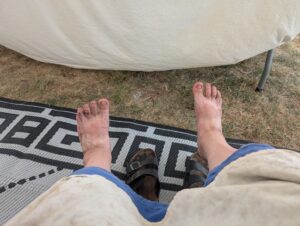 Sunday was more of the same, with lots of interactions with folks of the faire and with patrons. For some reason, perhaps the looming rain clouds, we didn’t get crowds as big as usual. Still, it was a lovely day. I got myself mostly packed by 1pm, so that if the big storm hit us square on, it would take only seconds to get everything packed under cover. As it turned out, the storm didn’t hit us until about 6pm, right during pack-down. That’s good for vendors and acts, but not nice for packing up. We were thoroughly soaked, and discovered that our new tent has a bit of a leak in it. We’ll need to purchase a waterproof fly to go over it, though that isn’t nearly so expensive as a tent.
Sunday was more of the same, with lots of interactions with folks of the faire and with patrons. For some reason, perhaps the looming rain clouds, we didn’t get crowds as big as usual. Still, it was a lovely day. I got myself mostly packed by 1pm, so that if the big storm hit us square on, it would take only seconds to get everything packed under cover. As it turned out, the storm didn’t hit us until about 6pm, right during pack-down. That’s good for vendors and acts, but not nice for packing up. We were thoroughly soaked, and discovered that our new tent has a bit of a leak in it. We’ll need to purchase a waterproof fly to go over it, though that isn’t nearly so expensive as a tent.
Near the end of the day, I snapped my usual “fair feet” picture and shared it on Facebook. Many of us do it. An honest day’s work, accompanied by an honest amount of filth on our feet. The red on my feet is not, as one might expect, sunburn. I got too close to the fire when taking a pot off, and the wind blew the flames over the tops of my feet. It’s nothing major and by the time I’m writing this on Tuesday, it’s largely healed. But it was impressive to look at initially.
If any of you come to the Maine Renaissance Faire, come over to the Brotherhood encampment to say hello!
